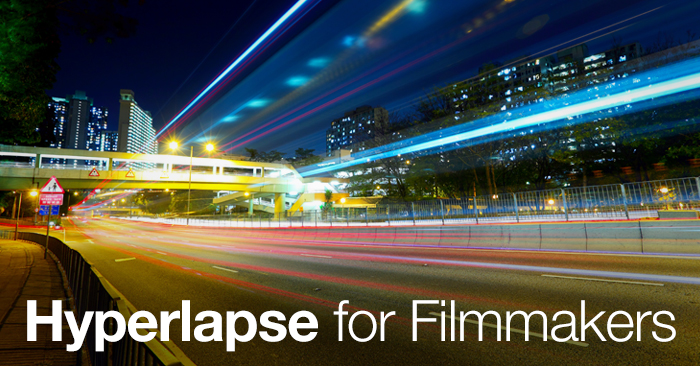
Hyperlapse for Filmmakers
In the future, all shots will be smooth.
By now, you’ve probably seen some of the amazing examples of timelapse imagery created with iPhones using Instagram Hyperlapse from Facebook. Many of these videos are stunning, even more so considering they are coming from a free app on a smartphone:
For the uninitiated: a hyperlapse is timelapse plus camera movement. Traditionally, a camera would be set up with an intervalometer to snap the shutter every minute (for example) – that’s the timelapse part. Place the camera on a motion control rig, move it to a new position with each shutter snap, and voíla, a ‘hyperlapse’.
While photo purists will argue whether or not a hyperlapse is a true “hyperlapse” (which they will certainly argue it is not), it is undoubtedly a very cool app, and not because it plays back your footage really fast. There is so much more going on under the hood than high speed playback of video footage. The secret sauce to hyperlapse is in the image stabilization function.
Using your smartphone’s accelerometer and gyroscope data, hyperlapse smooths out the jiggles and shakes of your handheld motion:
Because it can’t create something from nothing, hyperlapse scales your image to create enough spatial data to compensate for motion without seeing the edges of the frame. This is very similar to how After Effects Warp Stabilizer works, but rather than using pixel data to determine motion, hyperlapse uses real world motion data from the camera sensors. The scaling is adaptive, which means that if you have very little movement, then the scale is minor. If you have a lot of motion, then it will scale more. It’s a really smart way to do this.
This is one of those times in no-budget indie filmmaking where you realize that everything just got cheaper and easier. Rather than just making cool timelapse + motion shots of your daily commute, just ditch the speed up function and play everything back at 1x and make some movies!
Why not block out scenes using an iPhone with no tripod?
You could easily do long, mediums and close ups, covering a scene very quickly with a handheld phone. Just hold it relatively steady and shoot with hyperlapse — the shots will be solid. Tracking shots, booming up and down, dollies are all within arms reach, so to speak. While the video quality of the final product is relatively low-res (hyperlapse produces 720P/30 h264 files), a director and a couple of actors could easily block out actor and camera movement.
The Limitations
There are real drawbacks to using this tool to get a stable shot. For instance, scaling a 1080P image with heavy motion will soften and degrade an image, and may introduce motion blur artifacts. Particularly in low-light this may render a shot unusable. Hyperlapse, and really every piece of software image stabilization can’t fix, introduces motion blur. In shots with relatively little motion it’s not that big of a deal, but shots with a lot of motion blur look really strange — there is smooth motion, but the pixels dance with a constantly shifting and obvious directional blur.
Also, hyperlapse doesn’t give you many options when it comes to deciding the “smoothness” of a shot. The great thing about After Effects Warp Stabilizer is that you can decide on a degree of smoothness, how much to crop, etc. I get that an app like hyperlapse is about ease of use, and it is absolutely easy to use, but it would be nice to have a few sliders to tweak. It would also be great to be able tto shoot high bit rate video at 24 frames per second. And how great would it be to get a file that contained the original video clip, the motion data and the final smoothed clip all as separate elements that could be tweaked infinitely?!
The Future of Hyperlapse
With 4K smartphone cameras just around the corner and things like “Reduce Camera Shake” algorithms already in use, it is really easy to see where all this is headed. My guess is that within a year or two, the motion sensor + image data mashup will become standard not only on smartphone cameras, but also on DSLRs and Mirrorless.
As a bridge to that future, developers in France are creating a box that slaps right onto your existing camera, along with a stand alone piece of software that builds the final shots in post. It is called SteadXP. They are about to crowdfund it and say the unit will cost less than a GoPro when ready for market.
There are a couple of drawbacks to an attached device and post process, which I hope they figure out. One of the coolest things about hyperlapse (and physical stabilizers) is that you can review a shot right after you take it. Leaving that up to a post process means you never really know what you’re getting on set. Second, having an external device connected to your camera means some kind of calibration and syncing to get motion data and image data to line up. These are things that can go wrong and won’t be noticeable until you get back to a computer to crunch it all together. In the end, you may end up back in After Effects and Warp Stabilizer anyway.
If this is real, and it works like advertised, I expect the flood of brushless gimbal 3 axis stabilizers to subside. And I suspect there are some smart developers working right now on an app that lives on a smartphone and we’ll all be strapping an iPhone 6 to our DSLRs. And in no time, all pro cameras may have motion sensors built in and we’ll have to use an Instagram filter to simulate the authenticity of a “Shaky Shot”. Ok, ok, maybe that’s going too far.






